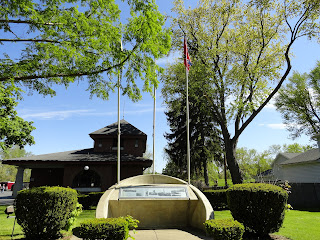One of the saddest chapters of the United States Civil War history is the story of Civil War prisoner of war camps.
At the start of the war, prisoners were exchanged fairly quickly, many times right on the battlefield. The exact systems used for this and later "paroles" are beyond the scope of this blog post, but there are a lot of sources online to read more.
Eventually these systems broke down. By the end of 1862, it was recognized that prisoners, on both sides of the war, needed to be held in a more permanent manner. And this is where the horror really started. By the end of the war, over 50,000. prisoners, from both sides combined, had perished.
Mention the word "Andersonville" to any well-educated American adult, and they will immediately recognize the name of what may have been one of the worst, if not the worst, of these prisons. The site is located in Georgia not that far from Americus (home of Habitat for Humanity) and Plains (home of former President Jimmy Carter). Today, you can visit Andersonville. I have, and I highly recommend that you do so, no matter what your nationality or ancestry. There is a Prisoner of War Museum there that you can spend hours in. Both Andersonville and the Prisoner of War museum are free of charge.
As my host in Americus told me, victors write history. The North won the Civil War and it is important to note that the North had its share of notorious prisons for its prisoners of war. The worst, perhaps,was Elmira Prison, located about an hour from where I live, in the City of Elmira, NY. Its prisoners called it Helmira.
At Helmira, don't look for a developed historical site, with multiple monuments, as you will find at Andersonville. Don't look for a visitor's center or a museum, either. In fact, if you don't know exactly where the site is, you may never find it. Signs in downtown Elmira point out sites related to Mark Twain, who summered in Elmira for 20 years. You will find no sign pointing you to Elmira Prison.
What you will find, if you persevere, is a residential neighborhood and a vacant lot near a city boat launch, and a building owned by the City of Elmira water department.
There is also a flagpole with an informational plaque.
There is also this monument.
Please note the monument is dedicated as much to the Northern
soldiers who trained at the site before it was a prison, as to the
Confederates who died there. Such a difference from Andersonville, where the Prisoner of War museum aims to make the POW experience universal.
This is part of the boundary between the camp and the neighborhood,
something called Foster's Pond. The pond is about 1/3 the size that it
was during the 1864-1865 period when the camp was used as a prison. It
was open for just about a year, and had to remain open after the war
ended in April of 1865 as some of the prisoners were too sick to be
transported home.
I will leave you with a picture of a community picnic pavilion near the site. I wonder how many people who rent it know about the history of the site.
If it is true that victors write history - we in the North should be doing a much better job with Helmira.





Thanks for sharing this important history lesson! Wow, the things we don't know until someone puts it in front of us.
ReplyDeleteWell I knew of Elmira, of course, but never gave any thought to if it had any interpretive center, etc. Interesting post. Intrigued by the picnic pavilion. Not sure I could celebrate there very easily (or at Andersonville).
ReplyDelete